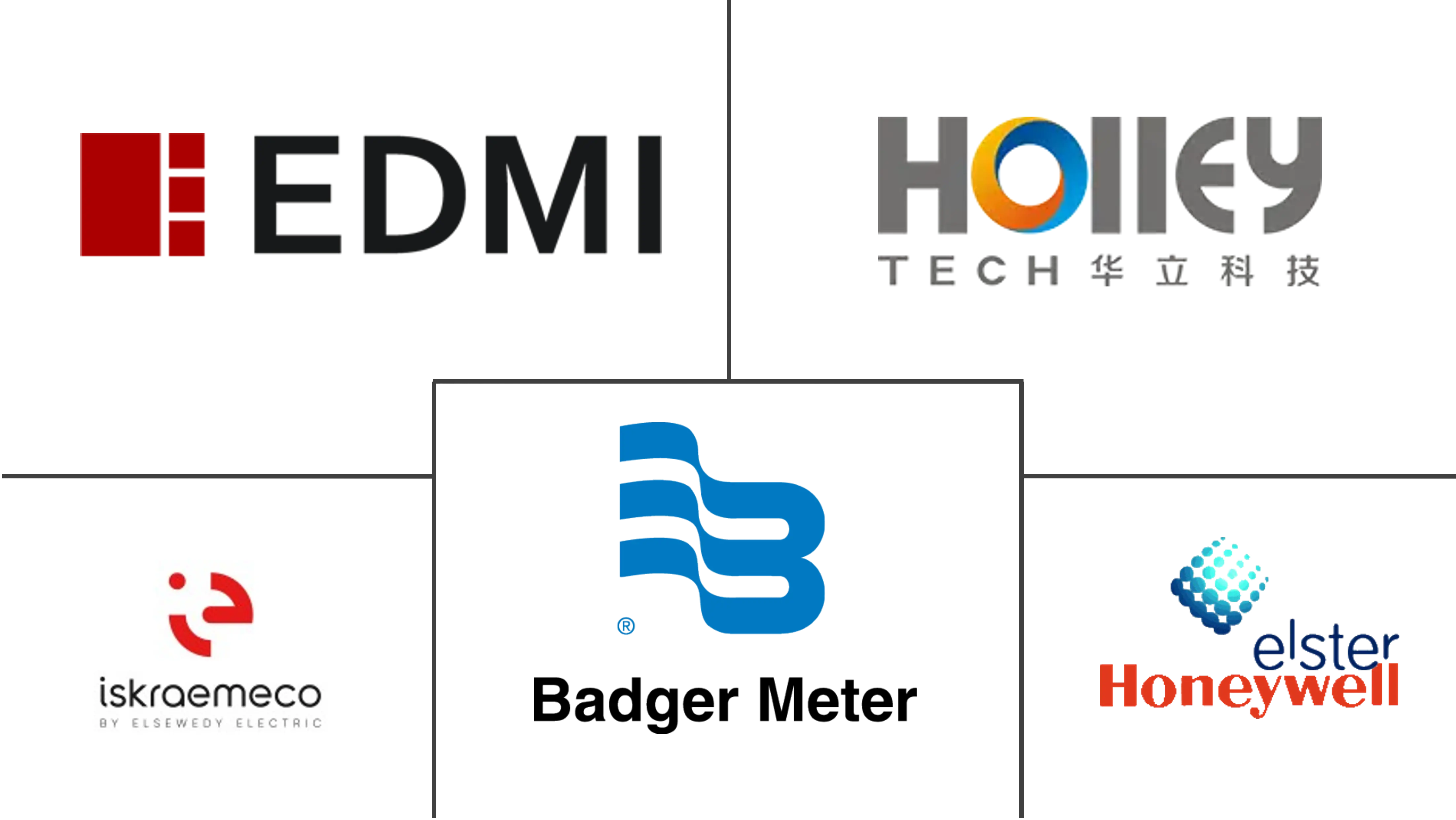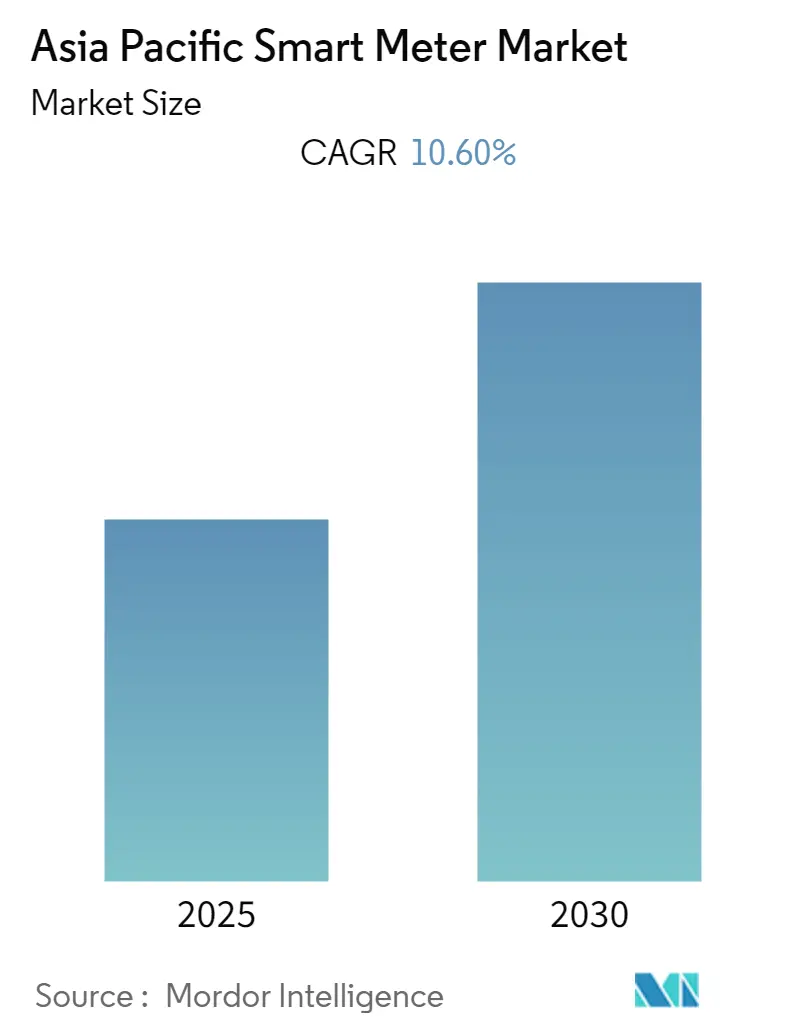
Asia Pacific Smart Meter Market Analysis by Mordor Intelligence
The Asia Pacific Smart Meter Market is expected to register a CAGR of 10.6% during the forecast period.
- The implementation of smart technologies such as analytics and cloud computing has increased significantly in the Asia-Pacific smart electric meter market. Several governments in the region have initiated smart city programs, which provide these businesses with a considerable growth opportunity. Furthermore, rising demand for remote monitoring and control of power grids would boost technological penetration in Asia-Pacific.
- Moreover, with smart city developments in China, Japan, India, and Australia, the need for smart water and smart gas meters in the region is predicted to rise in line with the UN's 2030 Agenda for Sustainable Development. In addition, pilot programs have been developed in Thailand and Malaysia, with more initiatives in Indonesia and the Philippines in the works. India has proven to be a difficult market for utility companies to convert to smart meters due to the country's low literacy rate.
- Electricity theft is higher than usual in India and Japan, although this can be reduced by using smart meters. In many underdeveloped economies, large-scale installations are prohibitively expensive due to low per capita electricity rates. Smart grid will boost smart meter market growth in the next years. Aside from that, both domestic and international smart metering providers are entering the market. As governments aim to solve energy sector concerns such as increases in energy demand and improve power quality, deployments of smart meters in China, Japan, Australia, and India are projected to increase in the Asia Pacific region.
- For Instance, Energy Efficiency Services Ltd's Smart Meter National Programme (SMNP) proposes that all conventional meters be replaced with smart meters by 2022, as recommended by Union Finance Minister in the 2020 budget (EESL). EDF, a French power company, and Energy Efficiency Services Ltd. installed roughly 1 lakh smart electric meters in India by 2020.
- China and South Korea are two especially isolated marketplaces with a significant number of local vendors serving their respective national utilities. Similarly, in the smart meter communications space, the countries have seen largely independent technology trajectories, with RF mesh, domestic PLC technologies, and cellular. In India's planned mass deployments, as well as in Australia's market-driven installations, cellular communications is projected to be a preferred alternative.
- Due to the implementation of lockdown in practically all major countries and the halting of non-essential operations, the COVID-19 pandemic has slowed the proliferation of smart meters. Due to a lack of focus on the development of the end user's industry, this had a negative impact on smart meters. Aside from that, manufacturing and supply chain delays have been seen, posing a barrier to smart meters. As people's movement was restricted, the manpower required for the initial arrangement of meters and installations was also hampered.
Asia Pacific Smart Meter Market Trends and Insights
Smart Electricity Meters Market is Anticipated to Grow at the Robust Pace
- The smart electric meter is important in the industrial, residential, manufacturing, and commercial sectors since it measures the amount of energy consumed by customers. By upgrading electricity infrastructure to smart meters, the electric power industry continues to move toward cleaner energy. It will allow electric firms to improve the resilience and operations of the electricity grid, as well as obtain more visibility into system operations and thereby avoid disruptions.
- Furthermore, the government's role in influencing the growth of the smart meter market in the Asia Pacific is influenced by the mandate and policy of installing smart meters throughout end-user sectors. During the pandemic in Malaysia, government regulatory bodies delayed the installation of smart meters. Nonetheless, with metering operations resumed, according to Tenaga Nasional Berhad (TNB), the number of smart meter customers will rise to more than 1.8 million by the end of 2021. When the 1.4 million analog meters in Singapore expire in 2024, they will be gradually replaced with smart meters.
- The creation of a strategic alliance by leading market vendors with communication technology providers to boost their offering and position is also likely to promote the smart electric meter in the Asia-Pacific market. With rising energy prices and environmental concerns about power generation and distribution, industries all over the world are looking for innovative, time-and cost-effective ways to manage power generation and distribution.
- For instance, the Indian government launched the Revamped Distribution Sector Scheme (RDSS) in 2021, which calls for the deployment of 25 crore smart prepayment meters by March 2025. Also, under the government of India's Smart Meter National Programme, India's state-owned Energy Efficiency Services Limited (EESL) completed the installation of about 10 lakh smart meters across the country. Over the next few years, EESL plans to deploy 25 million smart meters.
- In addition, Japan is heavily investing in the deployment of smart electric meters in order to keep energy expenditure low. Furthermore, it is concentrating on improving energy supply safety vulnerabilities that were exposed by the Fukushima Daiichi disaster's environmental catastrophe and huge outages in 2011.
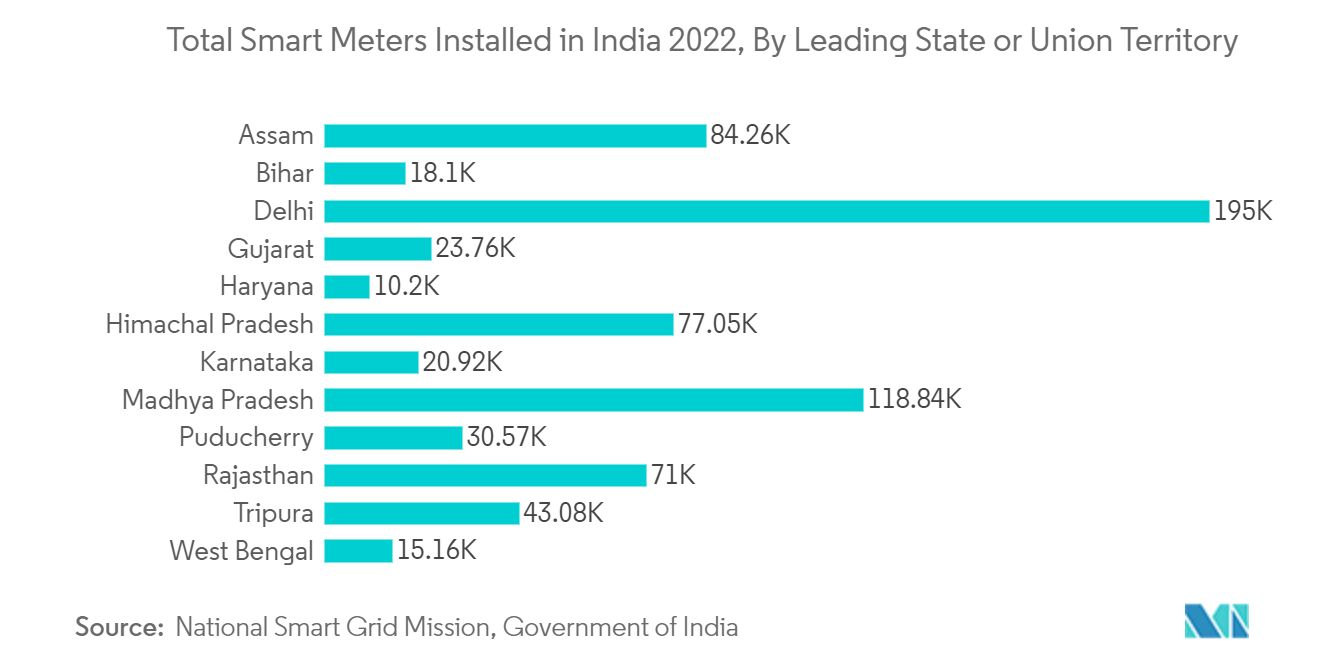
China is Expected to become as the Most Lucrative Market for Smart Meters
- China is investing extensively in smart grids that include metering. In the next few years, the smart meter industry will benefit from rising urbanization and increased demand for electric vehicles in the country. The ongoing actions in China to improve meters, transmission systems, distribution networks, and generating capabilities are assisting the country's smart meter market growth.
- Furthermore, according to the Council on Foreign Relations, China is the world's largest emitter of greenhouse gases and has been on the safe side due to the early implementation of smart meters. This has aided China's energy deployment optimization. As a result, a number of Chinese smart meter manufacturers are partnering with foreign firms to adapt their technology and develop their smart meter distribution market in China.
- As a result, the Smart Grid Corporation of China (SGCC) has been updating the power industry (including energy-equipment manufacture), minimizing the deployment of new coal-fired power plants, assuring a dependable power supply, and maintaining national power security over the last five years. These measures are propelling the smart meter data management industry forward.
- Also, According to China Academy of Information and Communications Technology (CAICT), China's smart grid market was worth almost 80 billion yuan in 2020, and it was projected to increase to about 85.5 billion yuan by the end of 2021. One of the most crucial phases in China's aim to establish low-carbon smart cities was the creation of the smart grid.
- Additionally, Increased infrastructure investments are driving the growth of the smart meter industry in the region. According to the Groupe Speciale Mobile Association, China is investing heavily in infrastructure to build a new 40,000-kilometer gas pipeline that will connect 470 million people. Such increased expenditures and infrastructural improvements are being used by industry participants to move the smart meter business forward.
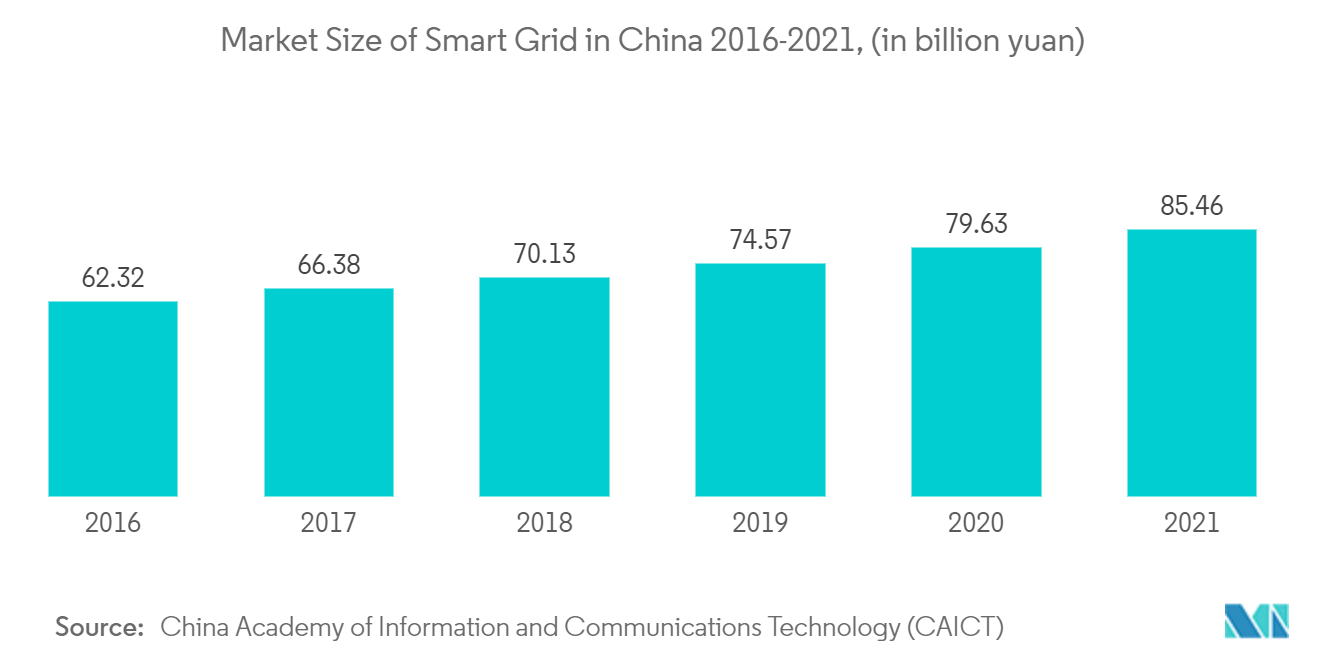
Competitive Landscape
The Asia Pacific Smart Meter Market is highly competitive and consists of several major players such as EDMI Limited, Holley Metering Limited, Iskraemeco India Private Limited, Badger Meter, Inc., and Honeywell (Elster Group). Due to the presence of large as well as Medium-sized enterprises, the given market is quite fragmented. The leading players in this market are concentrating their efforts on increasing their consumer base and expanding into other countries. These businesses are boosting their market share and profits by implementing strategic innovations and collaborative activities.
- May 2022 - Trilliant, a leading provider of advanced metering and smart grid technology, has announced a new partnership with SAMART to provide Thailand's Provincial Electricity Authority with Advanced Metering Infrastructure (AMI) (PEA). This deployment demonstrates Trilliant's ongoing commitment to utilities in the Asia-Pacific region at market-leading performance levels. In India and Malaysia, Trilliant has now connected over 3 million smart meters for clients.
- August 2021 - Tancy has been chosen by Indian utility Indraprastha Gas Limited (IGL) to supply smart gas meters for its grid upgrade program. Tancy will supply approximately 2000 rotary displacement gas meters, an electronic volume corrector, the Enesys Platform, and data hosting services to IGL over a five-year period.
Asia Pacific Smart Meter Industry Leaders
-
EDMI Limited
-
Holley Metering Limited
-
Iskraemeco India Private Limited
-
Badger Meter, Inc.
-
Honeywell (Elster Group)
- *Disclaimer: Major Players sorted in no particular order
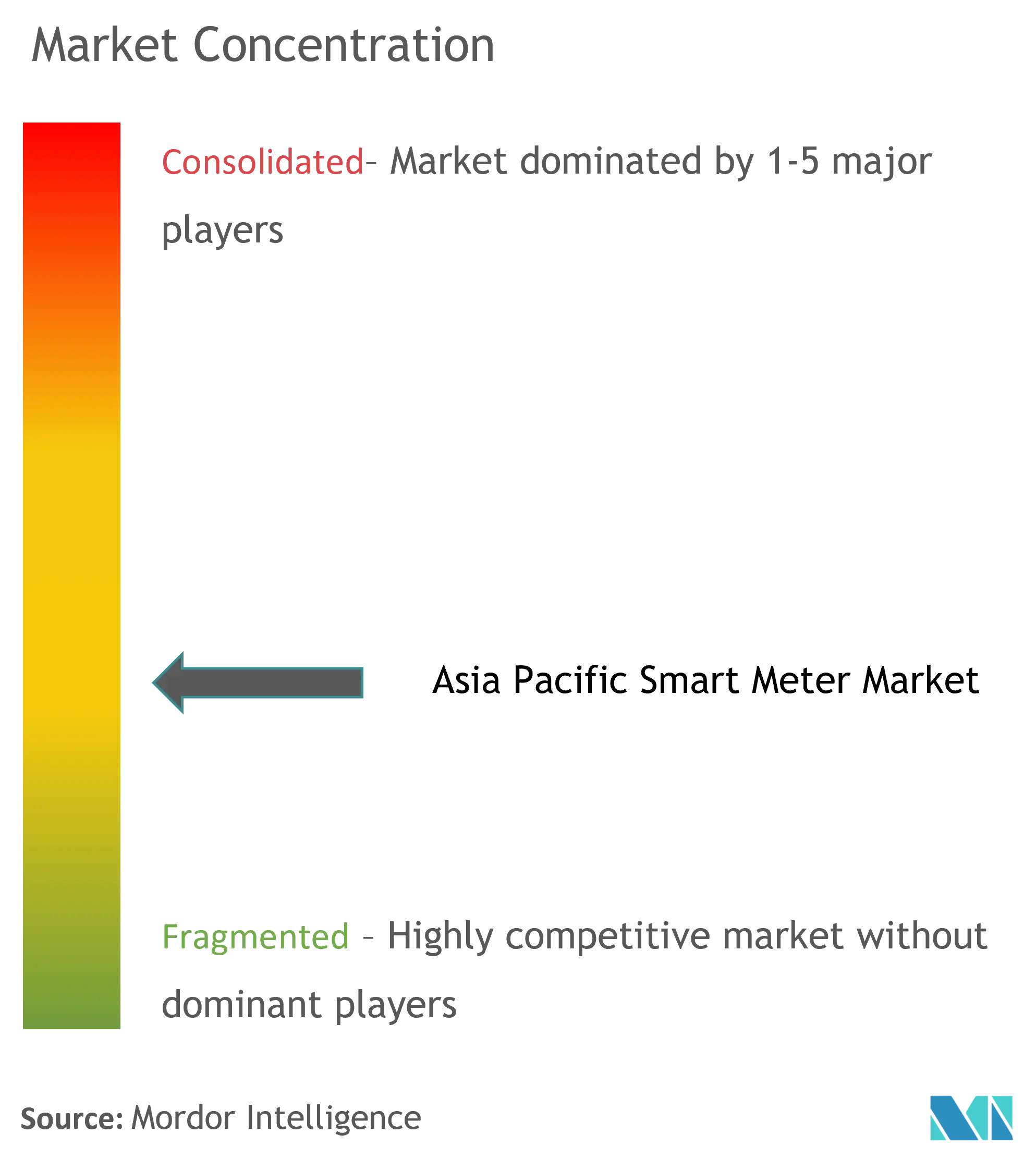
Recent Industry Developments
- June 2021 - The Electricity Generating Authority of Thailand (EGAT) announced that it will work with Hitachi Ltd. to improve the supply and demand balance on Thailand's power grid. Hitachi, Ltd, as the system vendor, is scheduled to deliver the project, which will include efforts to build a smart grid system that can improve rising renewables penetration, as well as a demand response system built by Chulalongkorn University.
- August 2020 - Genus Power Infrastructures Ltd has sold 1.5 million smart meters to Energy Efficiency Services Ltd, making it the first company in the Asia Pacific region to do so (EESL). Genus Power claims to be India's largest smart meter supplier, with a 10 million unit annual production capacity, its own in-house research and development tool, and superior software.
Asia Pacific Smart Meter Market Report Scope
Smart meters are digital meters that represent a transformative technology for the utility industry and its customers. It enables two-way communication between the meter and the supplier. These technologically advanced meters display real-time energy usage and provide greater insight into the usage of energy. These meters use a secure smart data network to automatically and wirelessly send the readings to the energy supplier to generate accurate bills and not estimated bills.
The different kinds of smart meters considered in the scope of the report are smart gas meters, smart water meters, and smart electricity meters. Further, it is segmented by end-user (residential, commercial, industrial) and by country.
| Smart Electricity Meter |
| Smart Gas Meter |
| Smart Water Meter |
| Residential |
| Commercial |
| Industrial |
| China |
| Japan |
| India |
| South Korea |
| Rest of Asia-Pacific |
| Smart Meter Type (Unit Shipments) | Smart Electricity Meter |
| Smart Gas Meter | |
| Smart Water Meter | |
| End User | Residential |
| Commercial | |
| Industrial | |
| Country (Unit Shipments) | China |
| Japan | |
| India | |
| South Korea | |
| Rest of Asia-Pacific |
Key Questions Answered in the Report
What is the current Asia Pacific Smart Meter Market size?
The Asia Pacific Smart Meter Market is projected to register a CAGR of 10.6% during the forecast period (2025-2030)
Who are the key players in Asia Pacific Smart Meter Market?
EDMI Limited, Holley Metering Limited, Iskraemeco India Private Limited, Badger Meter, Inc. and Honeywell (Elster Group) are the major companies operating in the Asia Pacific Smart Meter Market.
What years does this Asia Pacific Smart Meter Market cover?
The report covers the Asia Pacific Smart Meter Market historical market size for years: 2019, 2020, 2021, 2022, 2023 and 2024. The report also forecasts the Asia Pacific Smart Meter Market size for years: 2025, 2026, 2027, 2028, 2029 and 2030.
Page last updated on:
Asia Pacific Smart Meter Market Report
Statistics for the 2025 Asia Pacific Smart Meter market share, size and revenue growth rate, created by Mordor Intelligence™ Industry Reports. Asia Pacific Smart Meter analysis includes a market forecast outlook for 2025 to 2030 and historical overview. Get a sample of this industry analysis as a free report PDF download.
